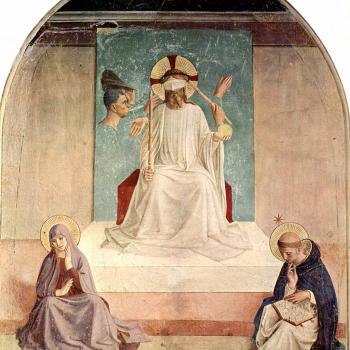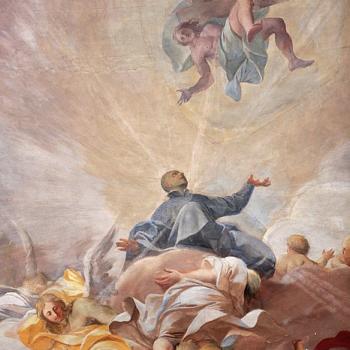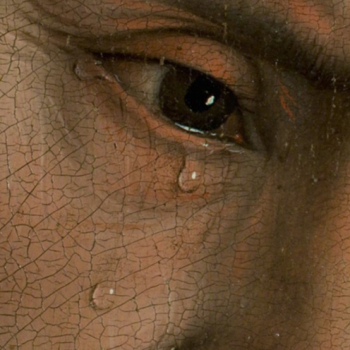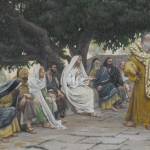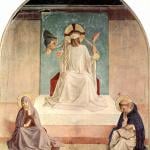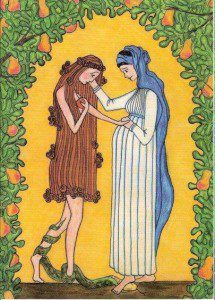 Holiness is a theological concept that under-girds the entire life of the Christian community. It is fundamental to the life and experience of the Church as well as the life of God as revealed to us. Although holiness is an adjective that is used to describe every member of the Trinity, the Creed connects it to the life of the community of faith in the third article as one of the four marks of the Church as an outworking of the life of the Holy Spirit – who is the object of the Creed’s third article. This special ministry of the Holy Spirit offers a way for the Christian Community to be joined in the life of the immanent Trinity through their encounter with the economic Trinity. I think that on this feast of the Immaculate Conception it will do us well to look at holiness. At it’s heart the theological basis of the Immaculate Conception is that Mary, as the one full of Grace, offers us a subjective view of Holiness which we are all called to. So let’s take a look at holiness for a moment together!
Holiness is a theological concept that under-girds the entire life of the Christian community. It is fundamental to the life and experience of the Church as well as the life of God as revealed to us. Although holiness is an adjective that is used to describe every member of the Trinity, the Creed connects it to the life of the community of faith in the third article as one of the four marks of the Church as an outworking of the life of the Holy Spirit – who is the object of the Creed’s third article. This special ministry of the Holy Spirit offers a way for the Christian Community to be joined in the life of the immanent Trinity through their encounter with the economic Trinity. I think that on this feast of the Immaculate Conception it will do us well to look at holiness. At it’s heart the theological basis of the Immaculate Conception is that Mary, as the one full of Grace, offers us a subjective view of Holiness which we are all called to. So let’s take a look at holiness for a moment together!
A – Holiness as a ministry of the Holy Spirit
The choice to include the holiness of the Church as part of its creedal explication on the Holy Spirit highlights how important the theology of the Holy Spirit is related to the theology of holiness generally. All hope of holiness is rooted in the Holy Spirit’s ministry within the life of the community of faith. To say something is holy is to affirm that it has been touched by God through the Holy Spirit. This is one of the key reasons that in the Eastern Church there developed quite early the tradition of including a pneumatological epiclesis to its Eucharistic anaphora early on; a practice which has now been included in the Western liturgical tradition as well.[1] We make space to affirm the Holy Spirit’s role in our liturgical and sacramental life.
All of the Christian life that is touched by holiness participates in the very holiness of God. This ontological communion is established and vivified by the active working of the Holy Spirit as it incorporates our temporal reality into the eternal perichoresis of the divine community of Father, Son and Holy Spirit. That is to say that God’s life breaks into the life of the Christian community through the ministry of the Holy Spirit. So while the participation of the faithful in God’s essential holiness is necessarily pneumatological in its facility, it is Trinitarian in its ontological grounding. Therefore an examination of Holiness as it relates to the life of the Godhead is also important.
B – The Holy Trinity
In the dogmatic constitution, Lumen Gentium, the Catholic Church grounds its understanding of holiness in the life of the Trinity. Human holiness is the destiny of man and an essential outworking of the divine plan to “raise men to a participation in the divine life.”[2] In other words human beings are created to be holy as God is holy. They are made for worship. As such, any understanding of holiness must be grounded in the theology of the Trinity.
The Catholic Church speaks of our relationship to each member of the Trinity in its theological reflection. In Lumen Gentium it identifies the holiness of the Father as the end of human salvation stating:
Fortified by so many and such powerful means of salvation, all the faithful, whatever their condition or state, are called by the Lord, each in his own way, to that perfect holiness whereby the Father Himself is perfect.[3]
This salvation is accomplished through the Son who offers himself as a model of holiness in which human nature might now participate, through the incarnation.[4] Jesus, in entering into the nature and life of humanity, offers humanity an opportunity for a restoration of the divine plan for human holiness. Through the pascal mystery the Father introduces human nature into the divine life, in the incarnation of Christ, through the working of the Holy Spirit.[5] In Christ, God’s intention for a humanity united in God’s own holiness finds its completion. The vivifying work of the Holy Spirit is expressed as it bonds the faithful into Christ in the new human community, with a divine destination: the Holy Church.
C – The Holy Church
In the mass of the Roman rite, the priest asks God to “confirm in faith and charity your pilgrim Church on earth.” This simple supplication formulates what the Church believes its own path to holiness is.[6] This prayer identifies the Church both as in the world, but also underscores that Church finds its origin and destination in God. In a word, the Church in the location on earth where “the spirit flourishes.”[7] As the St. John Paul II wrote of the Church,
Although the Church possesses a “hierarchical” structure, nevertheless this structure is totally ordered to the holiness of Christ’s members. And holiness is measured according to the “great mystery” in which the Bride responds with the gift of love to the gift of the Bridegroom. She does this “in the Holy Spirit”, since “God’s love has been poured into our hearts through the Holy Spirit who has been given to us.” [8]
We look to the Church as God’s instrument of sanctification in the world. Though there are sinners who serve in the church at every level, though faith, we know that God has ordained the Church as his tool to make a holy people. Therefore the Church remains central in the path to holiness, for it is the path itself.
D – The Saints
The holiness of the Christian Community mirrors the holiness of the Trinity in its incarnational expression. Because the Father draws men and women into his holiness through the Son, as members of the body of Christ are enlivened by the Holy Spirit they too become incarnational beacons of divine holiness in their own particular contexts. This truth is perhaps most powerfully seen in the person and ministry of Mary, the mother of God, who Catholic theology teaches was gifted with an “entirely unique holiness” so that she might become God’s “handmaid” is the “service of redemption.”[9] Mary is a model of what it means to be a “saint,” a word that literally means “holy one.” She is one who is made holy through Christ, in the Spirit, to the Father. As Henri de Lubac highlighted, Mary offers the Church holiness in the subjective form.[10]
Similarly many other men and women have been led into participation in God’s holy life. Some of these have been particularly recognized as “holy” by the Church, and have been formally canonized. Countless more have died without formal recognition, but the Church affirms them liturgically on All Saints Day, which is celebrated on November 1. These men and women offer their lives as concrete example of the continuing work of sanctification that God is extending to humanity through the ministry of Christ and the Holy Spirit in the Church. Through the saints the Holy Spirit “manifests his holiness and continues the work of salvation.”[11]
E – The Universal call to Holiness
The call to holiness does not end with the saints, but extends to all. Lumen Gentium dedicates its fifth chapter to exploring this theme.[12] It states that all members of the Church are called to be holy within the context of their individual lives. Each person is called to share in God’s holy divine nature in whatever way they are called, and gifted; and in whichever situation that they live in. Some are called to live this holiness as priests, others as religious, and others as members of the laity. Each vocation comes with its own challenges and opportunities for laboring in the love of Christ. These sacrifices build up the community of charity, which is the Church, God’s tool of sanctification; as well as witness to Christ to the world. Each person is also called to exercise their gifts and vocation in the liturgical and sacramental life of the Church, where God’s holiness is most readily offered for the life of the world.
Notes:
[1] For an excellent study on the history and theology of the Epiclesis in Christian liturgy, and how it became so closely associated with the role of the Holy Spirit in the sacramental life of the church see John McKenna, The Eucharistic Epiclesis: A Detailed History from the Patristic to the Modern Era (Chicago, IL: Liturgy Training Publications, 2009).
[2] Lumen Gentium (LG), 2
[3] LG, 11
[4] See the Catechism of the Catholic Church (CCC), paragraph 459.
[5] See CCC, 648.
[6] In Latin, “Ecclésiam tuam, peregrinántem in terra, in fide et caritáte firmáre dignéris” see: Catholic Church, Missale Romanum: Ex Decreto Sacrosancti Œcumenici Concilii Vaticani II Instauratum Auctoritate Pauli PP. VI Promulgatum Ioannis Pauli PP. II Cura Recognitum, Editio Typica Tertia (Libreria Editrice Vaticana, 2008), 1005.
[7] A phrase from The Apostolic Tradition, 35; as quoted in CCC, 749.
[8] Mulieris Dignitatem, 27
[9] LG, 56.
[10]For a full exploration by de Lubac on the relationship between Mary and the Church see: Henri de Lubac, The Splendor of the Church, trans. Michael Mason (San Francisco: Ignatius Press, 1999), 314–380.
[11] CCC, 688.
[12]LG, 39-41



